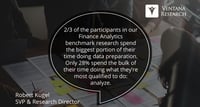Continuous planning is a term Ventana Research uses for a high participation, collaborative, action-oriented approach to planning built on frequent, short planning sprints. This enables organizations to enhance the accuracy of their plans because refinements are made at shorter intervals. Short planning cycles enable companies to achieve greater agility in responding to market or competitive changes. “Continuous” also means continuous across the entire organization – planning as an ongoing...
Read More
Topics:
Human Capital,
Business Collaboration,
finance,
Business
Business software is beginning to undergo a design revolution comparable to the seismic shift from the green screen to the graphical user interface (GUI) that began in the mid-1980s. Three forces are at work. One is the retirement of large numbers of members of the baby-boom generation and the rise of a generation that grew up with computers and computer games from a young age. Also, software and technology vendors have been recognizing the need to “consumerize” business applications as mobile...
Read More
Topics:
Big Data,
Sales Performance,
Salesforce.com,
Supply Chain Performance,
OpenWorld,
Operational Performance,
Business Performance,
Cloud Computing,
Customer & Contact Center,
Financial Performance,
Oracle,
Workforce Performance,
Dreamforce,
finance,
Tidemark,
Business,
design,
development,
GUI
The sun is shining and the birds are singing here in the Bay Area; in other climes, they aren’t. In recent years, I’m pleased to report, I’ve been spared having to deal with weather challenges in getting to the office. That’s in part because snow, sleet and hail aren’t a normal part of our weather here, but also in part because our physical office is a less important part of our operations than has ever been the case, so I can more often do my work from home.
Read More
Topics:
Operational Performance,
Business Intelligence,
Business Performance,
Collaboration,
Customer & Contact Center,
Operational Intelligence,
Business











